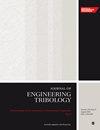Effect of micro-surface-texturing on the friction between cam/tappet interface of a commercial vehicle engine
IF 1.6
3区 工程技术
Q3 ENGINEERING, MECHANICAL
Proceedings of the Institution of Mechanical Engineers, Part J: Journal of Engineering Tribology
Pub Date : 2024-08-08
DOI:10.1177/13506501241266116
引用次数: 0
Abstract
Reduced wear and friction are directly related to longer component service lives and increased energy efficiency. The mechanisms used to achieve this goal in mechanical systems include the study of lubricant chemistry, surface coating, and surface modification. Significant research has been conducted on friction reduction of valve trains of internal combustion engines using surface modifications such as coatings and surface texturing. Here, an experimental approach has been adopted to investigate the effect of micro surface texturing on Thermo-Elastohydrodynamically Lubricated cam/tappet contact in a direct-acting valve train. A commercial vehicle valve train has been instrumented to study the effect of varying surface texture area density on friction under realistic engine operating conditions. Fiber laser surface texturing has been used to microtexture three samples of tappet shims with texture densities of 5%, 8%, and 10%. The tests have been run at four engine speeds—300, 500, 700, and 900 RPM—and three temperatures—30 °C, 60 °C, and 90 °C. The experimental results show a significant friction reduction of up to 18.33% for textured shims at the temperature of 90 °C. The friction reduction performance of the 8% textured shim has been optimum for all RPMs at the higher temperatures.微表面纹理对商用车发动机凸轮/挺杆界面摩擦的影响
减少磨损和摩擦直接关系到延长部件的使用寿命和提高能源效率。在机械系统中实现这一目标的机制包括润滑剂化学、表面涂层和表面改性研究。在利用涂层和表面纹理等表面改性技术降低内燃机气门机构摩擦方面,已经开展了大量研究。在此,我们采用了一种实验方法来研究微表面纹理对直动式气门机构中热等流体动力润滑凸轮/套筒接触的影响。对商用车气门机构进行了检测,以研究在实际发动机运行条件下,不同表面纹理面积密度对摩擦的影响。使用光纤激光表面纹理技术对三个挺杆垫片样本进行微纹理加工,纹理密度分别为 5%、8% 和 10%。测试在四种发动机转速(300、500、700 和 900 RPM)和三种温度(30 °C、60 °C 和 90 °C)下进行。实验结果表明,在 90 °C 的温度下,纹理垫片的摩擦力显著降低了 18.33%。在较高温度下,8% 的纹理垫片在所有转速下都具有最佳的减摩性能。
本文章由计算机程序翻译,如有差异,请以英文原文为准。
求助全文
约1分钟内获得全文
求助全文
来源期刊

CiteScore
4.20
自引率
5.00%
发文量
110
审稿时长
6.1 months
期刊介绍:
The Journal of Engineering Tribology publishes high-quality, peer-reviewed papers from academia and industry worldwide on the engineering science associated with tribology and its applications.
"I am proud to say that I have been part of the tribology research community for almost 20 years. That community has always seemed to me to be highly active, progressive, and closely knit. The conferences are well attended and are characterised by a warmth and friendliness that transcends national boundaries. I see Part J as being an important part of that community, giving us an outlet to publish and promote our scholarly activities. I very much look forward to my term of office as editor of your Journal. I hope you will continue to submit papers, help out with reviewing, and most importantly to read and talk about the work you will find there." Professor Rob Dwyer-Joyce, Sheffield University, UK
This journal is a member of the Committee on Publication Ethics (COPE).
 求助内容:
求助内容: 应助结果提醒方式:
应助结果提醒方式:


